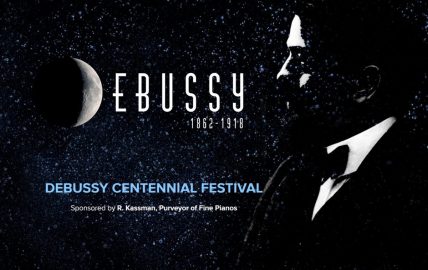
DEBUSSY MARCHED TO A DIFFERENT DRUMMER
Illuminating the otherwise underlit transition from summer stuff to the fall concert season, a four-concert splash of Debussy’s chamber music in San Francisco was welcome indeed, lighting up the night with as few as four performers each night, commemorating 100 years since the fascinating innovator’s death.
Composer Claude Debussy, as much as any one, had ushered in the era of modern music—plain and simple, he marched to another drummer. He broke with the strict dictates of the Theory of Harmony in vogue for nearly three centuries, going for parallel fifths, the whole tone scale, even the Devil’s Chord (that dissonant tritone chord of, say, C and F-sharp, which had jangled many nerves of the righteous). In the process he brought us enticing new discoveries, denser chords, and a feeling of a far broader sound space than every one had been brought up in.
The Frenchman Debussy (1862-1918) is most remembered for piano pieces like “Clair de lune,” plus “The Afternoon of a Faun,” an opera, a string quartet and that masterpiece of impressionistic music, “La mer” (The Sea). But while impressionistic, those works show only a glimmer of Debussy’s imagination with all its swoops, its stops, its lightning runs, and its constant changes of direction and mood. These flashes were abundant in the finale of the Debussy Centennial Festival given Aug. 24 in San Francisco devoted to works from his three final, fateful years.
These are heavy-hearted pieces from the midst of the carnage that was World War One, suggested by the mournful falling cascade of notes opening the Cello Sonata. That work was the highlight of the evening, with Michelle Kwon of the Delphi Trio doing the cello with exquisite sensitivity. Her light touch in this terse 12-minute opus was enviable.
Jeffrey LaDeur, the instigator of this Debussy fest, played all 12 Debussy etudes with his grandiose technique full of vigor and agility, providing close to an hour of tour-de-force piano. He brought out not only the study element for pianists mastering all the techniques one by one, but also contrasts and even emotions injected into the exercises. Particularly striking are the complex arpeggios, with masses of adjacent notes, like 5 PM crowds at a commuter-train station, going up and down scale at high speed, requiring nimble cross-overs of hands, which are as much rock-overs as cross-overs.
As in so much Debussy, more questions are raised than answers sought, with many changes of ‘gear,’ unresolved ideas, quirkiness and hesitations.
The many enigmas in the music recall an exchange a half century ago when composer-conductor Pierre Boulez became head of the NY. Philharmonic, declaring he wanted to dissipate all the mist and fog when interpreting Debussy’s music. Not long after, when Boulez had led that repertory at the Philharmonic, the renowned critic Harold Schoenberg sagely ventured in his review, the fog was the very element that made Debussy’s music so appealing to him.
The other works stumbled. Whether pairing with pianist Eunmi Ko in “Blanc et noir,” or with Liana Bérubé in the familiar Violin Sonata, LaDeur’s resonant piano drowned out the competition. Spending a half hour ironing out balancing problems would have been worth its weight in gold.
MUSIC NOTES—In the two-piano “En blanc et noir,” the cross fertilization of music between the two Parisian innovators, Stravinsky and Debussy, was audible. A surprise quote in the latter work’s slow movement featured the old hymn of the wartime German antagonists, “A Mighty Fortress Is Our God….” Debussy had indicated that some of his late music was his tribute to all the fallen soldiers in the bloody war…. When not playing here, Bérubé, Kwon and LaDeur collaborate as members of the Delphi Trio.
Old First Church has revolving door on its musicians’ green room, with new groups coming in to give concerts all the time, about twice a week.
Debussy Centennial (chamber) Festival in concluding concert Aug. 24 at Old First Church, 1751 Sacramento, at Van Ness, S.F. For info on the variety of First Church concerts: go online.